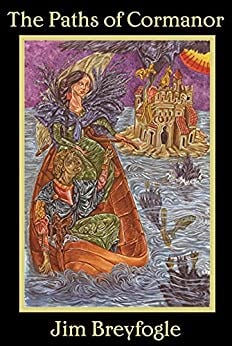The women of Cormanor possess the power to transform into cormorants, an ability which allows them to fly and dive for fish, the bones of which are carved for ornamentation and sold. Hearing tales of these fantastic women Prince Kellen, the seventh son of a seventh son and the youngest heir to the throne, sets out to visit Cormanor and see the women’s magic for himself.
Amara, the youngest female member of Cormanor House, is tasked with keeping an eye on the prince while her sisters show off. Distracted by her desire to fly with them, she misses seeing her youngest cousin falling into the lake. Noticing him fall, Kellen dives in to rescue the boy – inadvertently giving a lurking enemy the chance to strike.
The story
Following Kellen into the lake, Amara helps retrieve her cousin and the prince from the water, despite the efforts of something to prevent the rescue. While her cousin is fine the prince remains unresponsive even after they manage to get him breathing again. The matriarch of Cormanor determines that Prince Kellen’s soul has been stolen by the monster of the lake, the Grimly.
Having failed to watch over the young man as she was told, Amara takes on the task of retrieving his soul to make amends for her error. With her grandmother’s blessing and her family’s prayers, she sets off to the east side of the lake, where the Grimly lives. Transforming into a cormorant, she dives into the water and finds the monster’s lair, into which Amara swims before turning back into a human.
Amara soon finds her way into the old hag’s rooms, but her investigations are interrupted by the Grimly’s horrific son, Shrecken. Shrecken decides that this young woman won’t be his mother’s meal but his. When the Grimly summons him, he hides Amara in a wardrobe to keep her out of sight.
Of course, the girl frees herself quickly and manages to find Kellen’s soul. A brief fight ensues when the Grimly finds her but, through luck and determination, Amara manages to defeat the monster. She escapes the lair as Shrecken discovers his mother’s corpse, howling in rage and grief.
Although Amara makes it back to Cormanor and restores Kellen’s soul to him, there is a slight snag: the Grimly imbibed a small part of the prince’s soul when she captured him. When Amara killed her, she absorbed that piece into herself. Now Kellen has to find a way to recover that piece without harming Amara, whose family becomes the target of Shrecken’s greed and vengeance.
The characters
Without a doubt, the characters are what make this novel. Amara and Kellen are not the main viewpoint characters: at first glance, the book seems to be a typical fairy tale retelling from Amara’s point of view. But the next chapter is told from her cousin Einar’s perspective, which is exchanged for Vilmar the Marksgraf’s, and so on and so forth.
The transitions give readers a better understanding of Amara and Kellen by interpreting their actions through their interactions with others. Rather than confine the audience to two specific viewpoints, Breyfogle expands on his main protagonists and their world by showing the hero and heroine through the eyes of others, villain and hero alike. It makes the two more memorable and fun to read about than they would be otherwise.
The world
Paths of Cormanor has a rich world that is deeper than it first appears. After the first chapter it quickly expands and takes on the breadth of a novel set in a mythic past that has just enough Medieval or Dark Age pageantry to differentiate it from the Norse sagas and Beowulf. This isn’t some paint-by-numbers modern narrative dressed up to look like a Medieval tale. It is a genuine story steeped in Germanic lore, rooted deeply in the traditions it seeks to bring back to readers’ attention.
The politics
One of the most refreshing things about Paths is the absolute lack of politics. There’s no talk of women’s rights or sexism in the story at all; the men are men, and the women are women who are not at all averse to having men come to their rescue. It is a good story well told – a rare gem in today’s fantasy market.
Content warning
The violence described is no more graphic than that mentioned in Beowulf, though a child is murdered horribly “offscreen” during the course of the story. On the whole, this is a PG-13 book.
Who is it for?
To paraphrase the song, this book is “for kids from one to ninety-two.” Anyone can read and enjoy this novel, but those who love Norse myths and Germanic fairy tales will find it especially engaging. Fans of J.R.R. Tolkien will also love this story for delving into “that great northern spirit” which inspired the professor so much.
Why read it?
It’s a well-written, well-conceived fantasy written in a modern day that too often waters down myths and fairy tales to make them “relatable” for the audience. If that isn’t reason enough to buy it, read it, and keep it safely on one’s shelf, then the world truly has gone mad.




